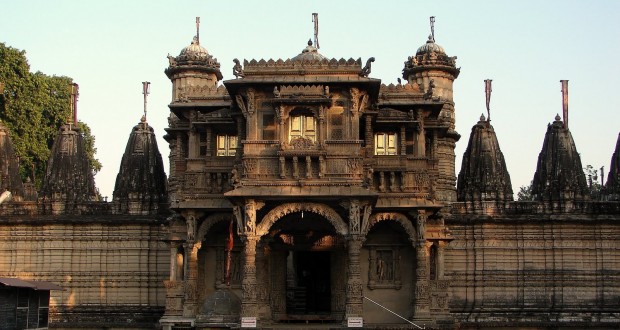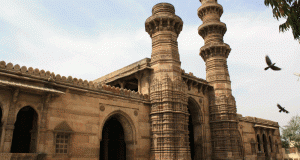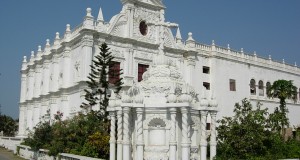Legend has it that present-day Ahmadabad was built on the ruins of the ancient township of 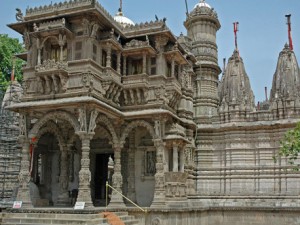 Karnavati, founded by King Karna Solanki in AD 1063-1093. Sultan med Shah. In 1411 he decided to build a town here after watching the rabbits on the banks of the Sabarmati river stand up to the royal hounds. Convinced that it was the site which made the normally timid creatures so brave, he founded a new city named after him.
Karnavati, founded by King Karna Solanki in AD 1063-1093. Sultan med Shah. In 1411 he decided to build a town here after watching the rabbits on the banks of the Sabarmati river stand up to the royal hounds. Convinced that it was the site which made the normally timid creatures so brave, he founded a new city named after him.
Ahmadabad, with its rich pre-Mughal and Mughal architecture, most of which survive today, was rightly called ‘The handsomest town in Hindustan, perhaps in the world’ by Sir Thomas Roe, an early British envoy to India. This city was a favourite of the great Mughal Emperors Bahangir and Shah Bahan.
During the 15th and 16th centuries a unique fusion of styles from Hindu and Muslim schools of architecture came together here to create what is now known as the Indo-Saracenic style. In Ahmedabad this is reflected in the mosques and mausolea in mellow, honey-colored-sandstone built during this period: in the arches, domes, vaults, pillars, jharokas and trefoil designs. A few centuries later, rich merchants of the Bain and Hindu faiths had a number of large temples built, and these still form a distinct part of Ahmedabad’s architectural landscape.
Modern Ahmedabad boasts of several public and private buildings designed by leading Indian 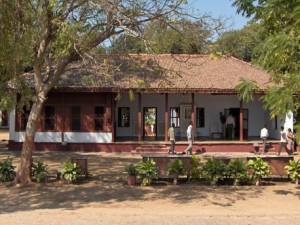 and international architects like Charles Correa, Louis Kahn and Be Corbusier. This is a city where ancient architectural marvels survive among the modern; where traditional values and a modern outlook coexist in peaceful harmony; where progress hasn’t meant the uprooting of all the ingrained customs ands moral values.
and international architects like Charles Correa, Louis Kahn and Be Corbusier. This is a city where ancient architectural marvels survive among the modern; where traditional values and a modern outlook coexist in peaceful harmony; where progress hasn’t meant the uprooting of all the ingrained customs ands moral values.
WHEN TO GO
April through to June can be quite hot, rising from 23°C to 43°C. There is no articular high season, as this is the commercial and industrial capital of Gujarat and has a busy stream of visitors throughout the year.
ARRIVAL/DEPARTURE
Ahmedabad is well-connected by air, rail and road to the rest of the country.
Air
Indian Airlines connects Ahmedabad with the four metropolitan cities of Bomba: (Rs1003), Delhi (Rs1509), Calcutta (Rs2935) and Madras (Rs2676); as well as Bar.- galore (Rs2488), Jaipur (Rs1083) and Jodhpur (Rs893). East West Airlines operates a daily flight to and from Bombay (Rs1003).
Rail
Western Railway links Ahmedabad to Bombay (492 km; 300 miles) and to Delhi (934 km; 5833/4 miles). The Ashram Express via Ajmer and Abu Road is the most convenient train from Delhi with departures each evening at 6 pm and arrival in Ahmedabad at 11.15 the next morning. There are link lines from Ahmedabad to Jamnagar (256 km; 160 miles), Porbandar (467 km; 292 miles) and other centres in the Saurashtra peninsula.
Road
Ahmedabad is connected by national and state highways with the major cities of India. State Transport buses ply from many centres including Bombay (492 km; 301 miles), Palitana (217 km; 135 1/2 miles), Sasan-Gir (219 km; 137 miles), Udaipur (287 km; 180 miles), Delhi via Udaipur and Jaipur (1076 kin; 672 1/2 miles).
GETTING AROUND
Ahmedabad was originally surrounded by a fortified wall built by Sultan Ahmed Shah but now the city has spread out and across the river Sabarmati. The newer portions of the city were built according to plan, so it is fairly easy to find one’s way about. The walled city with its maze of lanes, is divided into self-contained quarters locally known as poles. Each comunity of weavers, merchants, jewellers or goldsmiths had their own pole and it is still possible to wander on foot through this area. Although not often visited by tourists, the narrow streets crowded with activity, colour and full of noise make a visit a rewarding experience.

